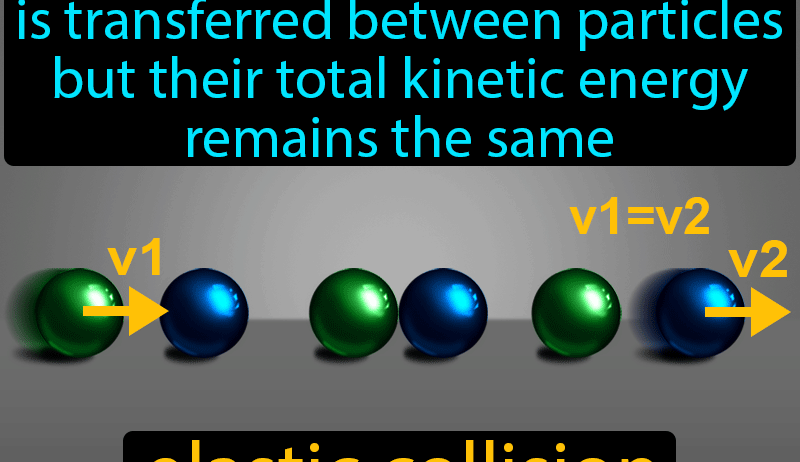Elastic collisions represent a fascinating domain within classical mechanics, where the principles governing kinetic energy and momentum coalesce into a succinct framework. But what does it mean for kinetic energy to be conserved in such interactions? To explore this intricate question, we must first delineate the characteristics of elastic collisions as opposed to inelastic collisions, where kinetic energy is not conserved.
In an elastic collision, two or more bodies collide and subsequently separate, maintaining both kinetic energy and momentum. The idealized scenario often involves two objects, classified as mass one (m₁) and mass two (m₂), each with initial velocities (v₁, v₂) before impact. Upon collision, these objects rebound, each adopting new velocities (v₁’, v₂’). The hallmark of elastic collisions is that the total kinetic energy before the interaction equals the total kinetic energy following the interaction.
Mathematically, this is articulated as:
K.E._initial = K.E._final
or
(1/2)m₁v₁² + (1/2)m₂v₂² = (1/2)m₁v₁’² + (1/2)m₂v₂’²
The conservation of kinetic energy is a critical consideration in examining elastic collisions. When two objects collide elastically, they do not dissipate energy as heat, sound, or deformation into their surroundings, a feature that distinguishes them from inelastic collisions. In the latter instances, a portion of the system’s kinetic energy transforms into other forms of energy, resulting in a loss of mechanical energy.
Consider the classic example of billiard balls on a pool table. When one ball strikes another, it transfers momentum and kinetic energy to the stationary ball. If both balls are of equal mass, thoroughly elastic collisions yield an intriguing outcome. The striking ball comes to a relative standstill after the collision, while the previously stationary ball acquires the velocity of the first ball. This phenomenon exemplifies the vigor of kinetic energy conservation.
Additionally, the intricacies of elastic collisions can be analyzed using one-dimensional equations. The equations encapsulate not only the conservation of kinetic energy but also the conservation of momentum. For any elastic collision in a one-dimensional context, it can be shown that:
m₁v₁ + m₂v₂ = m₁v₁’ + m₂v₂’
Here, conservation of momentum ensures that the total momentum prior to the collision equals the total momentum post-collision. As a result, a simultaneous solution of these two equations provides the velocities after the collision.
However, this elegant framework exists predominantly under idealized conditions. Real-world scenarios introduce complexities. Factors like friction, deformation, and heat dissipation can preclude the complete conservation of kinetic energy. Vehicles colliding during a crash, for instance, typically engage in inelastic collisions, as structural changes absorb significant amounts of the kinetic energy involved.
The segment of elastic collisions occurring at the atomic level further enhances our understanding of energy conservation. Consider gas molecules in a closed container. When these molecules collide elastically, they exchange energy through kinetic interactions without losing energy to their surroundings. This phenomenon reinforces the principles of thermodynamics and provides insight into the behavior of gases, such as the ideal gas law.
Yet another perspective arises when analyzing elastic collisions involving angles. Two-dimensional elastic collisions imbue additional layers of complexity, as we must account for both magnitude and direction of velocities post-collision. The two-dimensional approach involves vector components, where momentum conservation applies to both the x and y axes independently:
m₁v₁x + m₂v₂x = m₁v₁’x + m₂v₂’x
m₁v₁y + m₂v₂y = m₁v₁’y + m₂v₂’y
This vector analysis showcases the multifaceted interactions between colliding bodies, extending our comprehension even further.
To appreciate the broader implications of elastic collisions and the conservation of kinetic energy, one must reflect on their applications across various fields. In sports, engineering, and even astrophysics, understanding these fundamental principles catalyzes advancements in technology and methodology. The design of efficient vehicles, the mechanics of sports equipment, or the motion of celestial bodies can often be traced back to the underlying physics of collisions.
In conclusion, kinetic energy is conserved in elastic collisions under ideal conditions. By examining momentum and kinetic energy through mathematical equations and real-world scenarios, we unveil the elegance of energy conservation. The simplicity and predictability of these interactions are deceptive; they harbor a wealth of knowledge, prompting a shift in perspective regarding how we engage with physical phenomena. Fascination with such fundamental principles not only piques curiosity but also fosters deeper understanding—essential for addressing challenges in conservation and energy management in our rapidly evolving world.






